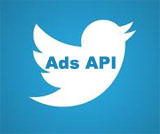 Twitter rolled out its long anticipated ads API program today, after a development process that began in earnest in the middle of last year.
Twitter rolled out its long anticipated ads API program today, after a development process that began in earnest in the middle of last year.
The APIs — one for Promoted Accounts, another for Promoted Tweets – are likely to lower barriers to demand for its paid media products, and to entice third parties to bring their secret sauce to its existing ad tools.
Five partners have been handed preferred access out of the gate: Salesforce.com, Adobe, TBG Digital, Shift, and HootSuite. Each brings its own cocktail of optimization technology, buying interface, strategic focus, customer positioning, and geographic location. And above all, they bring clients. (Twitter blog post)
“We’ve long known that an API is something we wanted to bring to market,” said Doug Williams, who leads business development at Twitter. He said Twitter based its partner decisions on scale, product differentiation, Twitter expertise, and endorsements from advertisers.
Williams said, and agencies agreed, that the API program will deliver three main value propositions: (1) Cross channel management, allowing advertisers to manage campaigns through unified interfaces of their choice; (2) workflow solutions, allowing multiple people to manage campaigns, supporting bulk upload of creative, and relieving other headaches; and (3) analytics, supporting the ability to repurpose analytics to improve campaigns in the future, both on Twitter and cross-platform.
Agencies AdExchanger spoke with are positive on the move.
Gerry Bavaro is Global Chief Strategy Officer for Omnicom Group’s Resolution Media, which has tested the APIs in beta for the past six to eight weeks. He cited a litany of benefits, including reduced creative labor, lower overhead, better reporting, and performance.
“The first thing we’re excited about is the ability to do bulk editing and creation of campaigns. For our clients there are sometimes hundreds of campaigns we edit. To do that separately campaign by campaign, sometimes for specific tweets, [is burdensome].”
And then there’s real-time reporting. He said, “The reporting has been very manual. You can see that a specific tweet we promoted has gotten engaged with, clicked on, or retweeted — to a degree. But I want to know how it’s performing across different segments.”
Serge Del Grosso, national head of media at SapientNitro, says the APIs make Twitter more relevant to the audience-buying ecosystem, and that marketers with a mindset of media efficiency will take another look at the company. “What you’re talking about is opening up the platform to volume ad buying. And opening up a new way of thinking about adding Twitter to a larger exchange-type ad buy.”
Twitter is following Facebook’s lead in that it is granting velvet API rope access to a handpicked group of partners, with plans for wider availability in the coming weeks. But the Twitter API appears more tightly controlled than Facebook’s, at least in its early rollout. It may want to avoid some of the confusion and mentality of budget scarcity that have plagued the Facebook Ads API badge community.
Among the partners…
Adobe said today it has already run campaigns through the API on behalf of Levi Strauss, Threadless, and its own Adobe account (Read the blog post, with bonus screenshots). On the in-house account it was able to increase followers by 63% at a cost per follow of $2.00. Follower acquisition went from two-dozen per day to approximately 400, before settling at a much higher post-campaign organic baseline of 115 per day.
Salesforce.com, meanwhile brings a sales/marketing/CRM spin, and is also focused on global companies. Michael Peachey, Senior Director of Solutions Marketing, said in an interview, “Social advertising can’t be on an island. Socal marketing needs to be connected with marketing, and with your sales organization and service organization as well.”
TBG Digital offers an agency-like model, often working directly with brands. It’s also based in London, and as such could help funnel European marketing budgets to Twitter’s platform.
SHIFT is focused on marketing collaboration between brands, agencies, and vendor partners. It will integrate the Twitter APIs with its GraphEffect social advertising app.
Hootsuite is the black sheep of the API partner list, bringing a strong focus on managing social media presence but an unclear value proposition when it comes to paid media. The company does have a long-proven understanding of the Twitter platform however.
When asked about timing for the next wave of partners, Williams demurred.
“I couldn’t tell you what the product is going to look like two quarters or a year out. Our philosophy when it comes to monetization, is we’re going to take a thoughtful approach. We’re going to do it right, rather than right now,” he said.
What does “right” look like? Put simply, more and better ads.
“Ultimately the goal is to make it easier for advertisers to work with the platform — getting better ads into the platform so users see more targeted messages. Advertisers and agencies are looking for tools to run across channels and manage campaigns at scale.”













